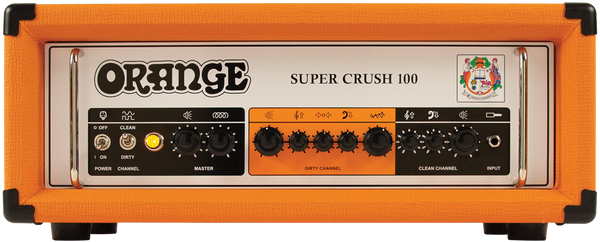Tube amplification remains the gold-standard for most players. But the growth and acceptance of digital modeling has made the issue much less black and white. In this more open field, where the presence of tubes has ceased to be a must, solid-state amplification may be finding a new audience. And light, inexpensive, and excellent sounding options like Orange Amplification’s Super Crush 100 may expand that audience even further. Taking inspiration from the company’s all-tube Rockerverb, it’s a flexible, 2-channel, solid-state, 100-watt, class A/B amp that can be had in head and 1x12 combo versions for $499 and $699.
Just Stacked Enough
The Super Crush 100 isn’t lean on features, but it’s pretty easy to navigate and work with. There’s a built-in digital reverb and a balanced XLR output that you can put to work via Orange’s CabSim speaker emulation technology, which offers closed- or open-back options via the CabBack switch. A channel switching footswitch isn’t included, but you can manually switch channels from the front of the amp. If you anticipate moving between clean and dirty a lot, Orange’s FS-2 footswitch ($41) is a worthwhile investment.
Like all Orange amps, the Super Crush 100’s control panel can be a little confusing to decipher if you’re new to the brand. Pictographs rather than words describe the function of each knob, but knowing what’s what becomes intuitive quickly. Otherwise, the layout is pretty straightforward. Master volume and reverb are shared by both channels. The dirty channel’s controls include volume, treble, middle, bass, and gain. The clean channel has controls for treble, bass, and volume.
- Mic Centered 1" Away: Clean
- Mic Centered 1" Away: Dirty
- Mic Centered 1' Away: Clean
- Mic Centered 1' Away: Dirty
- Mic Left of Center: Clean
- Mic Left of Center: Dirty
A Clean Slate
To gauge the Super Crush 100’s ability to, well, crush, I ran the amp through a Celestion-equipped 1x12 cabinet and tried it out with an Ernie Ball Music Man Axis Sport and a Schecter T-7 7-string guitar, as well as a Line 6 M9 patched into the fully buffered effects loop for delay.
The clean channel has two gain stages and sounds warm, if not super loud. With treble and bass knobs at noon and the channel volume up around 3 o’clock (and the master volume set more conservatively), the Orange had the lively feel and sound of an amp pushed right to the brink of distortion, but remained balanced and even in the high and low ends. Low E-string notes were robust and fat. And though I expected some solid-state brittleness from the highest strings, I was pleasantly surprised that the treble tones sounded just as full.
At lower volume levels (noon or less), the Super Crush 100’s clean channel is a fantastic pedal platform. The overall character at these settings is somewhat neutral and darker than a sparkly Fender-type clean. But if you’re like me and occasionally have a hard time matching certain pedals with the super sparkly voice of some Fender amps, the Super Crush’s capacity for optimizing pedal pairings will impress.
The Super Crush 100’s clean channel is a fantastic pedal platform.
Crushin’ It
Over on the dirty channel, I started in with the gain set low and noticed something interesting. Between the full-counter-clockwise and 9 o’clock positions, the gain control doesn’t deliver much in the way of volume or dirt. At 11 o’clock the amp starts to sound and feel discernibly loud but remains relatively clean. Once you get to about noon, though, power chords sound robust and beefy, and I found the sweet spot for both crunchy rhythm and lead guitar to be right around 1 o’clock and 3 o’clock. Within this range you can summon enough grit and sustain for heavy rock soloing and rhythm rock, or liquid, near-infinite sustain. Solos feel effortless and energetic at these settings—especially with a bridge humbucker in the mix. And even with this much gain, there’s lots of crisp definition and low-end clarity, and the amp feels responsive and fast. It’s also touch sensitive, with a dynamic range beyond what I’ve come to expect from a solid-state amp. At the 1 o’clock gain setting, I could clean up easily with a light picking touch or sound hyper-aggressive and commanding when I hit the strings hard.
Recording Ready
The Super Crush does a great job of facilitating creative recording, too. The XLR and CabSim emulation—which I routed to a Focusrite Scarlett 2i2, MacBook Pro, and GarageBand—make it easy to lay down tracks and take on silent recording tasks. The CabSim’s open- and closed-back options offer very different characteristics and, at least for the track I recorded, the open-back setting sounded more present and alive than the closed back. But both options are very useful, and the closed back will offer more low-end thump if that’s what you’re after.
The Verdict
If you’ve always lusted after an Orange Rockerverb but don't have $2,000 to spare, the Super Crush 100 is a killer alternative at a quarter of the price. While some tube purists might decry the lack of certain glassy tonalities, it still shines in the top end without sounding brittle and has lots of low-end power. But many more-convenience-minded players will revel in the Super Crush 100’s low maintenance and light weight (25 pounds) and amazing bang for the buck.



















